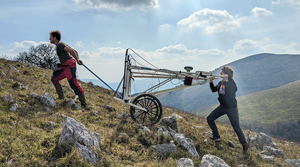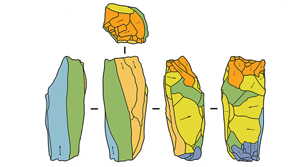Refine listing
Actions for selected content:
1418807 results in Open Access
The impact of finite span and wing-tip vortices on a turbulent NACA0012 wing
-
- Journal:
- Journal of Fluid Mechanics / Volume 997 / 25 October 2024
- Published online by Cambridge University Press:
- 22 October 2024, A68
-
- Article
-
- You have access
- Open access
- HTML
- Export citation
Long-term vestibular effects of blast trauma
-
- Journal:
- The Journal of Laryngology & Otology / Volume 139 / Issue 3 / March 2025
- Published online by Cambridge University Press:
- 22 October 2024, pp. 208-216
- Print publication:
- March 2025
-
- Article
- Export citation
The Enderby Bark Shield: A New Model for the Ancient World
-
- Journal:
- Proceedings of the Prehistoric Society / Volume 90 / December 2024
- Published online by Cambridge University Press:
- 22 October 2024, pp. 205-228
- Print publication:
- December 2024
-
- Article
-
- You have access
- Open access
- HTML
- Export citation
ON THE LOWEST ZERO OF THE DEDEKIND ZETA FUNCTION
- Part of
-
- Journal:
- Bulletin of the Australian Mathematical Society / Volume 111 / Issue 3 / June 2025
- Published online by Cambridge University Press:
- 22 October 2024, pp. 460-468
- Print publication:
- June 2025
-
- Article
- Export citation
Psychiatric co-morbidities and feasibility of an online psychiatric screening measure in children and adolescents with the Fontan circulation
-
- Journal:
- Cardiology in the Young / Volume 35 / Issue 1 / January 2025
- Published online by Cambridge University Press:
- 21 October 2024, pp. 109-116
-
- Article
-
- You have access
- Open access
- HTML
- Export citation
Wireless image transfer by various antennas using transmitter and receiver modules at 5.8 GHz
-
- Journal:
- International Journal of Microwave and Wireless Technologies / Volume 16 / Issue 7 / September 2024
- Published online by Cambridge University Press:
- 21 October 2024, pp. 1248-1259
-
- Article
- Export citation
Analysis of risk factors for prolonged stay in the intensive care unit after cardiac surgery in children with pneumonia
-
- Journal:
- Cardiology in the Young / Volume 34 / Issue 12 / December 2024
- Published online by Cambridge University Press:
- 21 October 2024, pp. 2679-2685
-
- Article
- Export citation
Investigation of vocal cord palsy aetiology: timing and relevance of imaging
-
- Journal:
- The Journal of Laryngology & Otology / Volume 139 / Issue 9 / September 2025
- Published online by Cambridge University Press:
- 21 October 2024, pp. 782-789
- Print publication:
- September 2025
-
- Article
- Export citation
Efficacy of the automated mechanical repositioning chair treatment for patients with benign paroxysmal positional vertigo
-
- Journal:
- The Journal of Laryngology & Otology / Volume 139 / Issue 1 / January 2025
- Published online by Cambridge University Press:
- 21 October 2024, pp. 34-39
- Print publication:
- January 2025
-
- Article
- Export citation
Dizziness and Vertigo - An Introduction and Practical Guide, Second Edition R G Kanegaonkar and J R Tysome (eds) CRC Press, Taylor and Francis Group, 2024 Pages 172 ISBN 9781032383514 pp 172 Price Paperback £42.99 Hardback £110.00 eBook £38.69
-
- Journal:
- The Journal of Laryngology & Otology / Volume 139 / Issue 3 / March 2025
- Published online by Cambridge University Press:
- 21 October 2024, p. 245
- Print publication:
- March 2025
-
- Article
- Export citation
RADIOCARBON CHRONOLOGY OF THE OCCUPATION OF THE SOUTHERN COAST OF NAYARIT, MEXICO
-
- Journal:
- Radiocarbon / Volume 66 / Issue 6 / December 2024
- Published online by Cambridge University Press:
- 21 October 2024, pp. 1753-1764
- Print publication:
- December 2024
-
- Article
-
- You have access
- Open access
- HTML
- Export citation
From worries to resilience: a qualitative study of the psychosocial experiences of diverse adolescents and young adults with heart failure and their caregivers
-
- Journal:
- Cardiology in the Young / Volume 35 / Issue 1 / January 2025
- Published online by Cambridge University Press:
- 21 October 2024, pp. 136-143
-
- Article
-
- You have access
- Open access
- HTML
- Export citation
Short- and medium-term longitudinal outcomes of children diagnosed with multisystem inflammatory syndrome in children - report from a single centre in Pakistan
-
- Journal:
- Cardiology in the Young / Volume 34 / Issue 12 / December 2024
- Published online by Cambridge University Press:
- 21 October 2024, pp. 2670-2678
-
- Article
-
- You have access
- Open access
- HTML
- Export citation
Unravelling 6000 years of interplay among environmental changes, anthropogenic activities, and Vesuvius eruptions in the upper Sarno Plain (Campania, Italy)
-
- Journal:
- Quaternary Research / Volume 122 / November 2024
- Published online by Cambridge University Press:
- 21 October 2024, pp. 18-39
-
- Article
- Export citation
Effects of daily almond consumption on glycaemia in adults with elevated risk for diabetes: a randomised controlled trial
-
- Journal:
- British Journal of Nutrition / Volume 132 / Issue 10 / 28 November 2024
- Published online by Cambridge University Press:
- 21 October 2024, pp. 1289-1299
- Print publication:
- 28 November 2024
-
- Article
-
- You have access
- Open access
- HTML
- Export citation
Esra Özyürek, Subcontractors of Guilt: Holocaust Memory and Muslim Belonging in Postwar Germany. Stanford, CA: Stanford University Press, 2023, 266 pages.
-
- Journal:
- New Perspectives on Turkey / Volume 71 / November 2024
- Published online by Cambridge University Press:
- 21 October 2024, pp. 211-214
-
- Article
- Export citation
Apotychiaphobia: should there be a term for fear of miscarriage?
-
- Journal:
- The British Journal of Psychiatry / Volume 226 / Issue 5 / May 2025
- Published online by Cambridge University Press:
- 21 October 2024, pp. 315-316
- Print publication:
- May 2025
-
- Article
-
- You have access
- HTML
- Export citation
ANNE-MARIE LEWIS, CELESTIAL INCLINATIONS: A LIFE OF AUGUSTUS. New York: Oxford University Press, 2023. Pp. 538, illus. isbn 0197599648 (hbk). £81.00; 9780197599662 (ePub); 9780197599679 (eBook).
-
- Journal:
- The Journal of Roman Studies / Volume 114 / November 2024
- Published online by Cambridge University Press:
- 21 October 2024, pp. 222-224
- Print publication:
- November 2024
-
- Article
- Export citation








